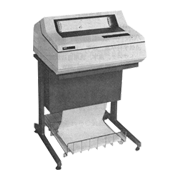In April 1980, NEC completed the KLP60C, Japan's first kanji line printer using the dot impact system. This printer achieved higher printing speed and greater durability than previous kanji serial printers by using the dot impact system.
With this machine, printing was done with a "hammer bank", comprised of 68 printing hammers, each having a printing pin for 1 dot at its tip, and these hammers were arranged in a horizontal linear array with a spacing of 5.08mm. The hammer bank shifted approximately 5.5mm to the left and right, and when printing was done for the 32 dot section handled by each printing hammer, the paper was moved 1 dot in the vertical direction. This process was then repeated.
The shuttle mechanism shifted the hammer bank with a DC servomotor, via a crank mechanism. This shuttle mechanism had no sliding parts, and required no lubrication. Vibration of the unit due to this left/right shifting was minimized by using a dynamic balancer.
This unit could also print overlays of software forms, and image data.
| Printing system | Dot impact |
|---|---|
| Dot pitch | Vertical 1/168inch,Horizontal1/160inch |
| Character types | Alphanumeric/kana 127char,Kanji (Chinese characters) approx. 8000char |
| Character composition,dimensions |
|
| Max. number of printed characters(char/line) | Alphanumeric/kana 136, Kanji (Chinese characters) 90 |
| Copy capability | 5sheets |
| Printing speed(line/min) | 60 (with 24×24 kanji (Chinese characters) |
| Paper width | 6–16inch |
| Noise | 60dB(A) |


